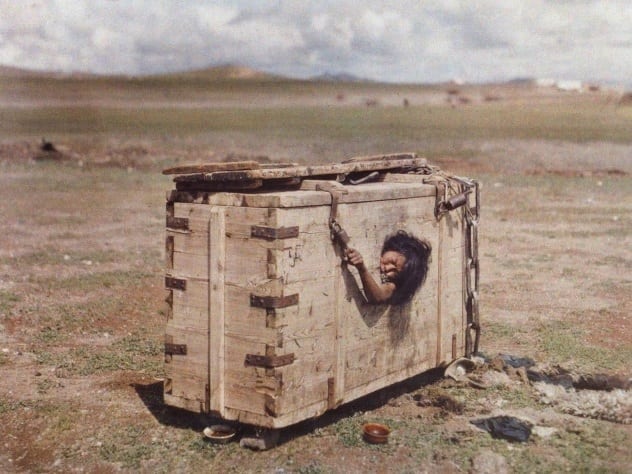 Mysteries
Mysteries  Mysteries
Mysteries  History
History 10 Surprising Stories About the Texas Rangers
 Humans
Humans 10 Philosophers Who Were Driven Mad by Their Own Theories
 Miscellaneous
Miscellaneous 10 Video-Game-Worthy Weapons and Armors from History
 Weird Stuff
Weird Stuff 10 Psychics Who Accurately Predicted Wartime Events
 The Arts
The Arts 10 Pieces of Art Inspired by a Broken Heart
 Health
Health 10 Science Fiction-Sounding New Medical Treatments
 History
History 10 Surprising Facts About the Father of Submarine Warfare
 Space
Space Ten Astonishing New Insights into Alien Worlds
 Weird Stuff
Weird Stuff 10 Bizarre Summer Solstice Rituals Still Practiced Today
 Mysteries
Mysteries Top 10 Haunting Facts About the Ghost Ship MV Alta
 History
History 10 Surprising Stories About the Texas Rangers
 Humans
Humans 10 Philosophers Who Were Driven Mad by Their Own Theories
Who's Behind Listverse?

Jamie Frater
Head Editor
Jamie founded Listverse due to an insatiable desire to share fascinating, obscure, and bizarre facts. He has been a guest speaker on numerous national radio and television stations and is a five time published author.
More About Us Miscellaneous
Miscellaneous 10 Video-Game-Worthy Weapons and Armors from History
 Weird Stuff
Weird Stuff 10 Psychics Who Accurately Predicted Wartime Events
 The Arts
The Arts 10 Pieces of Art Inspired by a Broken Heart
 Health
Health 10 Science Fiction-Sounding New Medical Treatments
 History
History 10 Surprising Facts About the Father of Submarine Warfare
 Space
Space Ten Astonishing New Insights into Alien Worlds
 Weird Stuff
Weird Stuff 10 Bizarre Summer Solstice Rituals Still Practiced Today
10 Ancient Methods Of Capital Punishment
The death penalty is the ultimate punishment for criminals to suffer. Even though this method of correction has seen a drastic decline in use in modern times, back in the old days, it was an everyday thing to see someone executed by the authorities. Often, convicted criminals were tortured and killed in brutal ways to set an example for everyone to witness the consequences of living a life of crime.
Across the world, each and every country had creative ways of delivering capital punishment. Most of the time, the idea was to make the criminal suffer for as long as possible, while at other times, the chosen method had some symbolic meaning behind it. Nevertheless, criminals never suffered honorable deaths. In fact, their remains were often displayed for extra humiliation.
Here are ten of the most brutal and horrific methods of capital punishment from ancient times.
10 Lingchi (Slow Slicing)

Lingchi was a brutal method of execution used in China in which the victim would suffer a multitude of cuts before eventually dying of blood loss. Executioners were tasked with making as many cuts as possible and removing slices of flesh without killing the victim. It was also known as “death by a thousand cuts.” Lingchi started in the tenth century and was outlawed in 1905. Since it saw the beginning of the 20th century, it is one of the few execution methods on this list for which photos of it being practiced actually exist.
There wasn’t a specific process behind lingchi. The experience of it depended on several factors, such as the skill and mercy of the executioner and the seriousness of the crime committed. Some records recovered from the Ming dynasty suggest that victims suffered as many as 3,000 cuts before dying, while other reports claim that the whole ordeal took less than 15 minutes. Sometimes, the condemned would be given opium, but whether it was to make them suffer more or less is unclear. (It could have kept them conscious for longer.)[1]Lingchi was one of the ultimate forms of the Five Punishments, which was a scale of punishment which increased in severity. It included a range of punitive measures, including amputation of the nose or feet, banishment, tattooing, and even castration.
9 Sawing

During medieval times in Europe, victims would be sawed to death for committing crimes like witchcraft, adultery, murder, blasphemy, and theft. The Roman Empire had a preference to saw victims in half horizontally, while the Chinese were more inventive by hanging their victims by their feet and sawing vertically down the body. This method was more effective in making victims suffer, because there would be better blood flow to the brain, prolonging consciousness.[2]
According to historical documents from the Czech Hussite reform movement, their victims would first suffer getting their hands and feet sawed off before the wounds were cauterized by a torch. Only then would the victim be sawed in half. As for ancient Rome, Caligula was known to enjoy a meal while watching people being sawed, relishing in the victims’ suffering during the extreme punishment.
8 Execution By Elephant

Also known as gunga rao, this form of punishment was mostly used in Asia and India, although there has been some evidence of this method being used in the Western world on rare occasions. Execution by elephant has been a form of capital punishment in India since the Middle Ages.[3] Victims would often be enemy soldiers or civilians who committed crimes like theft, tax evasion, and rebellion. Even though there was an abundance of animals that could be used for execution, elephants were utilized because of the fact that they could be trained to torture and kill criminals.
For example, an elephant could be commanded to crush a victim’s limbs before delivering the death blow to their head. Another example of execution by elephant was witnessed by Francois Bernier, a French traveler. In this method, the elephant was trained to slice criminals with blades that were fitted to their tusks.
7 Hanging, Drawing, And Quartering

According to English law, this would be the ultimate punishment for a man who has been convicted of high treason. Woman were burned at the stake instead for the sake of decency. Up until 1870, those who were convicted of high treason would be tied to a hurdle or sledge (similar to a piece of fencing made out of thin, interwoven branches) and dragged by a horse to the place of execution. Once there, the criminal would be hanged without a drop to ensure that their neck wouldn’t break. Before he died, the criminal would be cut down and have his genitals cut off and stomach slit open. The internal organs of the criminal would then be ripped out, and his body would be decapitated. Finally, the corpse would be divided into four quarters.
Often, the head and quarters of the criminal would be parboiled to prevent them from rotting and displayed on the city’s gates as a warning for everyone to witness. This sadistic method of execution first originated in 1241 to punish William Maurice, who had been convicted of piracy. The Treason Act of 1814 formally removed the disemboweling part of this method of execution and replaced it with hanging (now with a neck-breaking drop) and postmortem decapitation.[4]
6 Gibbeting

In Scotland, this form of capital punishment was reserved mostly for convicted murderers. According to the Murder Act of 1752, the bodies of executed murderers would either be dissected or hung in chains. Gibbeting disappeared in practice by the late 1770s, even though it remained a legal penal option up until 1834. One reason why this kind of capital punishment started to decline is the fact that the body of a criminal would be displayed in local areas, which had some obvious drawbacks.
The best variation of this method of capital punishment is the conviction of Alexander Gillan. He was a farmer’s servant who was convicted of the rape and murder of an 11-year-old girl named Elspet Lamb in 1810. She was busy herding her father’s cattle when he attacked her mercilessly and beat her to death. The lord justice clerk of that time wanted to pass on a death sentence that would be considered an exemplary response to the magnitude of the crime, so he decided that Gillan would be executed on the very same spot the body of his victim was found and have his body hanged in chains to serve as a reminder of the consequences of murder.[5]
5 Immurement

In this form of punishment, the convicted criminal would be placed within an enclosed space with no exits. Sometimes, this would translate into being imprisoned for life, while at other times, the victims would be condemned to die of starvation and dehydration. A photo which was first published in a 1922 issue of National Geographic depicted immurement in action, with a Mongolian woman trapped inside a wooden box in the desert. The photographer, Albert Kahn, witnessed how the woman would beg for food. He had to leave her in the box, because it would have been a huge breach of protocol for an anthropologist to intervene with another culture’s criminal justice system.[6]
According to Kahn, the woman had been convicted of adultery. Even though there were doubts behind the story of why she was condemned to this fate, the photo has an indisputable authenticity. Victims did not always die of starvation. According to a newspaper report from 1914, sufferers of this fate in China were entombed in heavy iron-bound coffins which prohibited them from sitting upright or lying down. For only a few minutes a day, they’d be able to see sunlight as their food was thrown into their coffins through a small hole.
4 Poena Cullei

Also known as “punishment of the sack,” those who were found guilty of killing a parent (parracide) would be sewn up inside a leather sack along with an assortment of live animals and thrown into water. According to the the first documentation found mentioning poena cullei, only snakes would be thrown into the sack. Yet, around the time of Emperor Hadrian, the most popular variation of poena cullei was to throw a cock, a dog, a monkey, and a viper along with the criminal inside the sack.
During that time, those convicted of parracide had the choice of being thrown to the beasts in an arena or to suffer the fate of poena cullei. People sentenced to poena cullei were first whipped or beaten with blood-colored rods while their head was stuffed into a bag. After that, they would be thrown into a sack made of ox-leather along with other live animals and placed in a cart pulled by oxen to a running stream or the sea, into which they’d be thrown into. Eventually, poena cullei was replaced with being burned alive.[7]
3 Scaphism

This was an ancient Persian method of torture reserved for those who committed serious crimes such as murder or treason. Criminals would be trapped in a hollowed-out tree trunk or between two boats (hence why this method was also called “the boats”) and force-fed milk and honey. This punishment had to take place in a swamp or someplace where the boats could lie exposed in the sun. Not only were they forced against their will to swallow the mixture, but it was also spread all over their exposed body parts. This would attract various kinds of insects as well as rats, which would basically eat the victim alive.
The victims of scaphism also suffered from severe diarrhea after a period of time that left them feeling weak and dehydrated. Yet, they didn’t die because of diarrhea-induced dehydration because they were constantly force-fed more milk and honey. This means that they could survive for days and even weeks in a small Hell of their own feces, milk, honey, and devouring insects. Eventually, the victim’s accumulating feces would breed a torrent of maggots and other vermin. Slowly, the they would make their way into the victim’s body and eat them up from the inside, finally bringing death.[8]
2 The Breaking Wheel

Also known as the “Catherine wheel” because it’s associated with Saint Catherine of Alexandria, this brutal torture device was used during medieval times in Europe. It was popular in France and Germany, and in some instances, it was still in use even after medieval times. It earned the name “the breaking wheel” because it was specifically designed to break the bones of its victims. Men who were convicted of aggravated murder suffered this kind of capital punishment. The victim would be lashed to the wheel, and a club or iron cudgel was then used to beat his limbs. Once the victims succumbed to their injuries, the wheel could be used to display their bodies.
Sometimes, the victim would face days of torture on the wheel, while at other times, the executioner would deliver several blows to the chest and stomach (also known as the “coups de grace”) for a quicker death. The exact mechanism of the wheel used varied from country to country, and some variations of the torture device even included a wooden cross.[9]
1 The Garrote

Execution by garrote were first introduced in 1812 as an alternative to hanging. At least 736 people were executed by garrote in Spain during the 19th century. Usually, those who were condemned to suffer this method of capital punishment were found guilty of crimes like murder, banditry, or major acts of terrorism. Prisoners would be seated with their backs against a post, and a rope loop which was also attached to the pole would then be placed around their necks. Executioners would then use a stick inserted into the loop of the rope to strangle them. There was also a Chinese variation of this execution method involving the use of bowstring.[10]
Over time, several improvements were made to ensure that those who were condemned to die by the garrote would be killed in a more humane way. The whole method of garroting changed to accommodate a wooden stool, with restraints for the hands and feet as well as a hinged iron collar to be closed around the neck. Along with the wooden stool came a screw/lever mechanism with a star-shaped blade attached to it. This would then be used to enter the prisoner’s neck and sever the spinal column, effectively preventing the prisoner from strangling to death. Even though the victim usually lost consciousness quickly and died after a few minutes, it was never a guaranteed outcome. This led to the conclusion that this method of execution was never quicker or more humane than hanging.
You can follow me on Twitter @JustThatChickXD.
Read about more ways to execute condemned criminals on Top 10 Gruesome Methods of Execution and 10 More Gruesome Methods of Execution.








